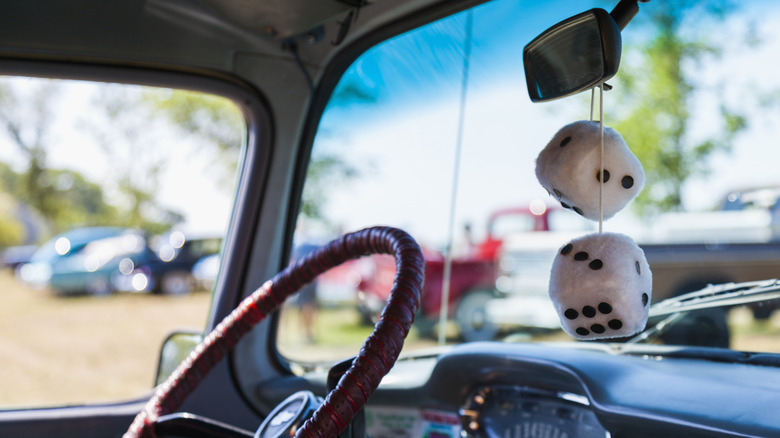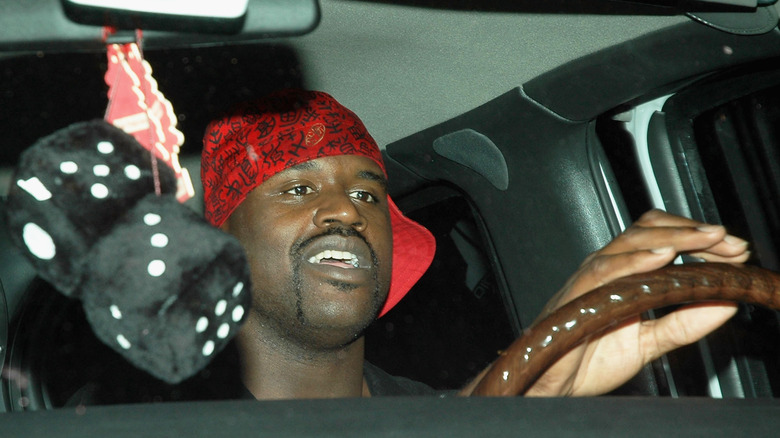The Weird Theory About The History Of Fuzzy Dice (And Why We're Skeptical)
Today, rearview mirrors are a ubiquitous part of every automobile. We're taught to check and adjust them to minimize blind spots in your car as an integral part of learning how to drive, but they've also become a convenient place to hang things. Over the decades, they've been an anchor for all manner of trinkets like air fresheners, baby shoes, garter belts, tiny disco balls, graduation tassels, COVID masks ... the list goes on. And yes, that list includes fuzzy dice.
The origins of these particular car ornaments are fuzzy at best and can't be pinpointed to a singular moment in history. Plus, no one has ever claimed to be the creator of the craze that swept the nation. Common folklore places the appearance of fuzzy dice sometime in the 1950s, but an issue of the Detroit Free Press from August 1999 said they were "a staple in hot rod magazines" as far back as the late 1940s. The timing here is crucial because it's most likely why fuzzy dice are directly associated with World War II fighter pilots.
This is very unlike the history of the rearview mirror itself. Back in 1909, an industrious auto engineer, businesswoman, and journalist by the name of Dorothy Levitt (Britain's first female race car driver ) wrote a book called "The Woman and the Car: A Chatty Little Handbook for Women Who Want to Motor." In it, she suggests carrying a small handheld mirror, preferably with a handle, to safely observe cars approaching from the rear. One source claims she actually used one during races as early as 1906 to see if other vehicles were quickly approaching and trying to pass her.
Lucky number 7
During the inaugural Indianapolis 500 in 1911, American race car driver Ray Harroun (whose pit crew included Clessie Cummins, founder of the Cummins diesel engines) attached a piece of mirrored glass just above the cowling of his Marmon Wasp race car to see vehicles behind him — and won the race. This first known use of an attached "rearview mirror" prompted the automobile industry to begin installing them on passenger cars. Interestingly, the National Highway Traffic Safety Administration didn't get around to federally mandating their requirement until 1976.
Depending on which source you check, total U.S. military casualties during World War II ranged between 407,316 and 416,800. According to the Utah Wing of the Commemorative Air Force, 2.3 million combat missions were run with the best fighter planes the U.S. had to offer. Approximately 6,600 American servicemen died every month, and by the time the war officially ended in September 1945, total pilot casualties amounted to almost 122,000. Flying missions into enemy territory was, in every sense of the word, a gamble — a literal roll of the dice, if you will — where only the lucky ones survived.
As such, pilots routinely placed good luck charms in their cockpit, which were typically associated with gambling, like casino chips and dice (with seven pips showing on the dice). For pilots lucky enough to survive combat, those tokens of good fortune — now seemingly imbued with the power to save their lives — were brought back home with them. Upon returning stateside, postwar veterans greatly impacted society, including the explosive growth of what we know as suburbia ... and hot rods.
Dicing with death
Veterans were also looking for a way to keep their thrill-seeking need for speed going. These "militarized mechanics" used the readily available surplus of military parts and the mechanical skills they learned during the war to help create the massive hot rod movement of the 1950s. Interestingly, veterans were also integral to the rise of biker gangs in the United States after the war.
Personalizing an automobile was an integral part of hot rodding. From striking paint jobs to pinstripes, flames, or a tchotchke dangling from the rearview mirror ... anything to make a vehicle stand out and make it uniquely theirs. Part and parcel of the urban legends surrounding that era was the notion that hanging dice was a way to give notice to other drivers that they were ready to roll the dice in the kind of dangerous and illegal street race (aka "dicing with death") that was taking hold in many places around the country. These races fueled the competitive fire that, for many, was akin to the rush felt during combat sorties.
This connection to World War II combat pilots and their lucky charms is the most logical explanation for the spark that lit the match behind the fuzzy dice craze. When veterans returned, they were embraced as the heroes who fought fascism and won. And remember, the Detroit Free Press did say in 1999 that fuzzy dice were "a staple in hot rod magazines" dating back to the late 1940s (just as veterans were returning home), so the timing works. But those magazines almost certainly helped spread the fad from sea to shining sea because who doesn't want to be like their heroes?
So where did the fuzzy part come from?
Well, again, no one really knows for sure. Pilots weren't hanging fuzzy dice in their planes, so it didn't start there. Some sources report that global warming began to raise temperatures in the 1950s, enough so that the previously plastic dice were melting in the sun. So, manufacturers started tinkering with substitute materials like foam or fabric, which ultimately became labeled "fuzzy dice" and became one of the first items expressly made and sold to be suspended from the rearview mirror.
Others suggest that creative girlfriends began crocheting replacement dice when the originals fell apart or melted. Still, another source points to a shift in American culture that occurred during the late '50s and early '60s when "angora-type fur" became all the rage, and people were buying car seats, steering wheels, and doors (and dice?) made with the stuff.
Then, you have the introduction of laws surrounding items hung from the rearview mirror. Many states today have laws that make it illegal to hang anything from the rearview mirror that might cause a visual obstruction when the vehicle is in motion. According to an old issue of The Gridley Herald, it was illegal in California to hang fuzzy dice (or anything else that might impair a driver's view) as far back as January 1958. These laws vary from state to state and can have wildly different levels of interpretation and enforcement (much like the laws surrounding window tint), so if you feel the urge to dice it up, be sure to check your state laws (even if you're a celebrity). Ultimately, the history surrounding fuzzy dice will likely remain shrouded in folklore and legend.



